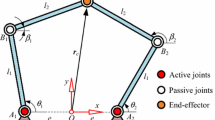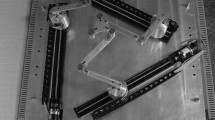Abstract
The objective of this paper is to identify the trajectory that accomplishes the assigned motion with the maximum dynamic load-carrying capacity (DLCC) which is subject to constraints imposed by the kinematics and dynamics of a manipulator structure. In this study, the possible trajectories of the manipulator are modeled using a parametric path representation, the optimal trajectory is then obtained using a two-loop of optimization process, in which the inner-loop optimization process based on the Simplex-type linear programming method is used to determine the dynamic loading at each discrete point along the presumed trajectory and then to formulate the DLCC; the outer-loop optimization process based on the particle swarm optimization algorithm is to solve the controlled points by maximizing the formulated DLCC. The numerical results confirm the feasibility of the optimized trajectories and demonstrate the effectiveness of the proposed algorithm for the maximum dynamic load-carrying trajectory planning of a parallel kinematic manipulator.



















Similar content being viewed by others
References
Merlet J-P (2000) Parallel robots, 2nd edn. Springer, Berlin
Siciliano B, Khatib O (2008) Handbook of robotics. Springer, Berlin
Shiller Z, Dubowsky S (1989) Robot path planning with obstacles, actuator, gripper, and payload constraints. Int J Robot Res 8:3–18
Yun W, Xi Y (1996) Optimum motion planning in joint space for robots using genetic algorithms. Robot Autonom Syst 18(4):373–393
Chettibi T, Lehtihet HE, Haddad M, Hanchi S (2004) Minimum cost trajectory planning for industrial robots. Eur J Mech A 23(4): 703–715
Shiller Z, Chang H, Wong V (1996) The practical implementation of time-optimal control for robotic manipulators. Robot Comput Integr Manuf 12(1): 29–39 (1996)
Constantinescu D, Croft A (2000) Smooth and time-optimal trajectory planning for industrial manipulators along specified paths. J Robot Syst 17(5):233–249
Park J, Bobrow JE (2005) Reliable computation of minimum-time motions for manipulators moving in obstacle field using a successive search for minimum-overload trajectories. J Robot Syst 22(1):1–14
Pugazhenthi S, Nagarajan T, Singaperumal M (2002) Optimal trajectory planning for a hexapod machine tool during contour machining. Proc Inst Mech Eng Pt C 216(12):1247–1256
Abdellatif H, Heimann B (2005) Adapted time-optimal trajectory planning for parallel manipulators with full dynamic modeling. In: Proceedings of IEEE international conference on robotics and automation, Barcelona, Spain, pp. 411–416 (2005)
Afroum M, Chettibi T, Hanchi S (2006) Planning optimal motions for a DELTA parallel Robot. In: IEEE 14th Mediterranean conference on control and automation, Ancona, Italy, pp. 1-6 (2006)
Oen KT, Wang LC (2007) Optimal dynamic trajectory planning for linearly actuated platform type parallel manipulators having task space redundant degree of freedom. Mech Mach Theory 42:727–750
Wang LT, Ravani B (1988) Dynamic load carrying capacity of mechanical manipulators: part I and II. J Dyn Syst Meas Control 110(1):46–61
Thomas M, Yuan-Chou HC, Tesar D (1985) Robotic manipulators based on local dynamic criteria. J Mech Transmiss Autom Des 107:163–169
Wang LT, Kuo MJ (1994) Dynamic load-carrying capacity and inverse dynamics of multiple cooperating robotic manipulators. IEEE Trans Robot Autom 10(1):71–77
Korayem M, Ghariblu H (2003) Maximum allowable load on wheeled mobile manipulators imposing redundancy constraints. J Robot Autonom Syst 44(2):151–159
Korayem M, Ghariblu H, Basu A (2005) Dynamic load-carrying capacity of mobile-base flexible joint manipulators. Int J Adv Manuf Technol 25:62–70
Yue S, Tso SK, Xu WL (2001) Maximum-dynamic-payload trajectory for flexible robot manipulators with kinematic redundancy. Mech Mach Theory 36:785–800
Korayem M, Shokri M (2006) Maximum dynamic load carrying capacity of 6UPS Stewart platform flexible joint Manipulator. In: Proceeding of IEEE international conference on robotic and biomimetic, Kunming, China, pp 727–736
Chen CT (2012) Hybrid approach for dynamic model identification of an electro-hydraulic parallel platform. Nonlinear Dyn 67(1):695–711
Chen CT, Pham HV (2012) Trajectory planning in parallel manipulators using a constrained multi-objective evolutionary algorithm. Nonlinear Dyn 67(2):1669–1681
Afroun M, Dequidt A, Vermeiren L (2012) Revisiting the inverse dynamics of the Gough-Stewart platform manipulator with special emphasis on universal-prismatic-spherical leg and internal singularity. Proc Inst Mech Eng Pt C 226(10):2422–2439
Khalil W, Guegan S (2004) Inverse and direct dynamic modeling of Gough-Stewart robots. IEEE Trans Robot Autom 20(4):754–762
Khalil W, Ibrahim O (2007) General solution for the dynamic modeling of parallel robots. J Intell Robot Syst 49:19–37
Saravanan R, Ramabalan S, Balamurugan C (2008) Evolutionary optimal trajectory planning for industrial robot with payload constraints. Int J Adv Manuf Technol 38:1213–1226
Kreisselmeier G, Steinhauser R (1979) Systematic control design by optimizing a vector performance index. In: Proceedings of IFAC symposium Computer-aided design control system, Zurich, Switzerland, pp. 113–117
Kennedy J, Eberhart R (1995) Particle swarm optimization. In: IEEE international conference on neural networks, Perth, WA, pp 1942–1948
Clerc M, Kennedy J (2002) The particle swarm-explosion, stability, and convergence in a multidimensional complex space. IEEE Trans Evol Comput 6(1):58–73
Acknowledgments
This work was supported by the National Science Council of the ROC under the Grant NSC 101-2221-E-003-002.
Author information
Authors and Affiliations
Corresponding author
Appendix
Appendix
Inertia matrix, Coriolis and centrifugal terms, gravity vector
and \({\varvec{I}_{\varvec{i}}} ={\varvec{I}_{\varvec{i}{\mathbf{1}}}} + {\varvec{I}_{\varvec{i}{\mathbf{2}}}} - m_{{i2}} l_{{\varvec{i}{1}}}^{2} \tilde{\varvec{s}_{i}}^{{2}} + m_{i2} l_{i1} \left( {\tilde{\varvec{s}}_{\varvec{i}}^{T} \tilde{{\varvec{d}}}_{\varvec{i}\mathbf{2}} + \tilde{{\varvec{d}}}_{\varvec{i}\mathbf{2}}^{T} \tilde{\varvec{s}}_{\varvec{i}} } \right),\quad i = 1, \ldots ,6,\)
where \(\varvec{h}_{\varvec{i}} = {m}_{{{i}2}} {\dot{l}}_{{{i}1}} ({l}_{{{i}1}} \tilde{\varvec{s}}_{\varvec{i}}^{T} + \tilde{{\varvec{d}}}_{{\varvec{i}2}}^{T} )\tilde{\varvec{s}}_{\varvec{i}}\,+((\varvec{I}_{{\varvec{i}\varvec{1}}} + \varvec{I}_{{\varvec{i}\varvec{2}}} ) \otimes \varvec{\omega }_{\varvec{i}} )^{T} + {m}_{{{i}2}} {l}_{{{i}1}} (\varvec{\omega }_{\varvec{i}}^{T} {\varvec{d}}_{{\varvec{i}\varvec{2}}} )\tilde{\varvec{s}}_{\varvec{i}}^{T} ,\quad i = 1, \ldots, 6\)
The actuating torques: τ = [τ 1 … τ 6].
It is noted that the symbol “⊗ ” in D 1 and h i denotes a skew-symmetric matrix formed from the matrix–vector product. The skew-symmetric matrix has the form like Eq. (5).

L = diag[p 1/2π … p 6/2π].
Rights and permissions
About this article
Cite this article
Chen, CT., Liao, TT. Trajectory planning of parallel kinematic manipulators for the maximum dynamic load-carrying capacity. Meccanica 51, 1653–1674 (2016). https://doi.org/10.1007/s11012-015-0308-8
Received:
Accepted:
Published:
Issue Date:
DOI: https://doi.org/10.1007/s11012-015-0308-8




